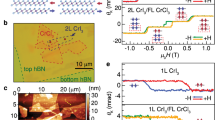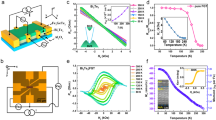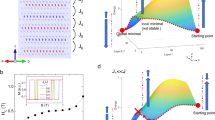Abstract
Magnetic topological insulators such as Cr-doped (Bi,Sb)2Te3 provide a platform for the realization of versatile time-reversal symmetry-breaking physics. By constructing heterostructures exhibiting Néel order in an antiferromagnetic CrSb and ferromagnetic order in Cr-doped (Bi,Sb)2Te3, we realize emergent interfacial magnetic phenomena which can be tailored through artificial structural engineering. Through deliberate geometrical design of heterostructures and superlattices, we demonstrate the use of antiferromagnetic exchange coupling in manipulating the magnetic properties of magnetic topological insulators. Proximity effects are shown to induce an interfacial spin texture modulation and establish an effective long-range exchange coupling mediated by antiferromagnetism, which significantly enhances the magnetic ordering temperature in the superlattice. This work provides a new framework on integrating topological insulators with antiferromagnetic materials and unveils new avenues towards dissipationless topological antiferromagnetic spintronics.
This is a preview of subscription content, access via your institution
Access options
Subscribe to this journal
Receive 12 print issues and online access
$259.00 per year
only $21.58 per issue
Buy this article
- Purchase on Springer Link
- Instant access to full article PDF
Prices may be subject to local taxes which are calculated during checkout




Similar content being viewed by others
References
Chen, Y. L. et al. Massive Dirac fermion on the surface of a magnetically doped topological insulator. Science 329, 659–662 (2010).
Qi, X.-L., Hughes, T. L. & Zhang, S.-C. Topological field theory of time-reversal invariant insulators. Phys. Rev. B 78, 195424 (2008).
Yu, R. et al. Quantized anomalous Hall effect in magnetic topological insulators. Science 329, 61–64 (2010).
Li, R., Wang, J., Qi, X.-L. & Zhang, S.-C. Dynamical axion field in topological magnetic insulators. Nat. Phys. 6, 284–288 (2010).
Mahfouzi, F., Nagaosa, N. & Nikolic, B. K. Spin–orbit coupling induced spin-transfer torque and current polarization in topological-insulator/ferromagnet vertical heterostructures. Phys. Rev. Lett. 109, 166602 (2012).
Chang, C. Z. et al. High-precision realization of robust quantum anomalous Hall state in a hard ferromagnetic topological insulator. Nat. Mater. 14, 473–477 (2015).
Chang, C. Z. et al. Experimental observation of the quantum anomalous Hall effect in a magnetic topological insulator. Science 340, 167–170 (2013).
Kou, X. et al. Metal-to-insulator switching in quantum anomalous Hall states. Nat. Commun. 6, 8474 (2015).
Jiang, Z. et al. Independent tuning of electronic properties and induced ferromagnetism in topological insulators with heterostructure approach. Nano Lett. 15, 5835–5840 (2015).
Lang, M. et al. Proximity induced high-temperature magnetic order in topological insulator–ferrimagnetic insulator heterostructure. Nano Lett. 14, 3459–3465 (2014).
Wei, P. et al. Exchange-coupling-induced symmetry breaking in topological insulators. Phys. Rev. Lett. 110, 186807 (2013).
Yang, W. et al. Proximity effect between a topological insulator and a magnetic insulator with large perpendicular anisotropy. Appl. Phys. Lett. 105, 092411 (2014).
Katmis, F. et al. A high-temperature ferromagnetic topological insulating phase by proximity coupling. Nature 533, 513–516 (2016).
Takei, W. J., Cox, D. E. & Shirane, G. Magnetic structures in the MnSb–CrSb system. Phys. Rev. 129, 2008–2018 (1963).
Snow, A. I. Magnetic moment orientation and thermal expansion of antiferromagnetic CrSb. Rev. Mod. Phys. 25, 127 (1953).
Nogués, J. & Schuller, I. K. Exchange bias. J. Magn. Magn. Mater. 192, 203–232 (1999).
Shiratsuchi, Y. et al. Detection and in situ switching of unreversed interfacial antiferromagnetic spins in a perpendicular-exchange-biased system. Phys. Rev. Lett. 109, 077202 (2012).
Kirby, B. J. et al. Phase-sensitive specular neutron reflectometry for imaging the nanometer scale composition depth profile of thin-film materials. Curr. Opin. Colloid Interface 17, 44–53 (2012).
Borchers, J. A. et al. Long-range magnetic order in Fe3O4/NiO superlattices. Phys. Rev. B 51, 8276–8286 (1995).
Lenz, K., Zander, S. & Kuch, W. Magnetic proximity effects in antiferromagnet/ferromagnet bilayers: the impact on the Neél temperature. Phys. Rev. Lett. 98, 237201 (2007).
Manna, P. K. & Yusuf, S. M. Two interface effects: exchange bias and magnetic proximity. Phys. Rep. 535, 61–99 (2014).
Wu, X. W. & Chien, C. L. Exchange coupling in ferromagnet/antiferromagnet bilayers with comparable TC and TN . Phys. Rev. Lett. 81, 2795–2798 (1998).
Mauri, D., Siegmann, H. C., Bagus, P. S. & Kay, E. Simple model for thin ferromagnetic films exchange coupled to an antiferromagnetic substrate. J. Appl. Phys. 62, 3047–3049 (1987).
Liu, Z. Y. & Adenwalla, S. Oscillatory interlayer exchange coupling and its temperature dependence in [Pt/Co]3/NiO/[Co/Pt]3 multilayers with perpendicular anisotropy. Phys. Rev. Lett. 91, 037207 (2003).
Wilson, M. J. et al. Interlayer and interfacial exchange coupling in ferromagnetic metal/semiconductor heterostructures. Phys. Rev. B 81, 045319 (2010).
Abanin, D. A. & Pesin, D. A. Ordering of magnetic impurities and tunable electronic properties of topological insulators. Phys. Rev. Lett. 106, 136802 (2011).
Zhu, J. J., Yao, D. X., Zhang, S. C. & Chang, K. Electrically controllable surface magnetism on the surface of topological insulators. Phys. Rev. Lett. 106, 097201 (2011).
Liu, Q., Liu, C. X., Xu, C., Qi, X. L. & Zhang, S. C. Magnetic impurities on the surface of a topological insulator. Phys. Rev. Lett. 102, 156603 (2009).
Li, M. et al. Experimental verification of the van Vleck nature of long-range ferromagnetic order in the vanadium-doped three-dimensional topological insulator Sb2Te3 . Phys. Rev. Lett. 114, 146802 (2015).
Jiang, Y. et al. Mass acquisition of Dirac fermions in magnetically doped topological insulator Sb2Te3 films. Phys. Rev. B 92, 195418 (2015).
Nguyen, V. D. et al. Detection of domain-wall position and magnetization reversal in nanostructures using the magnon contribution to the resistivity. Phys. Rev. Lett. 107, 136605 (2011).
Acknowledgements
We thank S. Watson, R. Erwin and W. Chen for their assistance in the neutron diffraction experiment. We are also grateful for the support from the Army Research Office accomplished under Grant Number W911NF-15-1-10561. We also acknowledge the support by the Spins and Heat in Nanoscale Electronic Systems (SHINES), an Energy Frontier Research Center funded by the US Department of Energy (DOE), Office of Science, Basic Energy Sciences (BES) under award #SC0012670, and the National Science Foundation (DMR-1411085). This work was supported in part by the FAME Center, one of six centres of STARnet, a Semiconductor Research Corporation program sponsored by MARCO and DARPA. Certain commercial equipment, instruments, or materials are identified in this paper to foster understanding. Such identification does not imply recommendation or endorsement by the National Institute of Standards and Technology, nor does it imply that the materials or equipment identified are necessarily the best available for the purpose.
Author information
Authors and Affiliations
Contributions
Q.L.H., X.K. and K.L.W. conceived and designed the experiments. Q.L.H., L.P., X.C. and K.M. performed the sample growth and device fabrication. B.Z. and X.H. carried out the TEM experiments. All the authors contributed to the measurements and analyses. A.J.G., S.M.D., B.J.K., W.R.II and J.A.B. performed the neutron experiments and analyses. Q.L.H., X.K., A.J.G., G.Yin and K.L.W. wrote the manuscript with contributions from all the authors.
Corresponding authors
Ethics declarations
Competing interests
The authors declare no competing financial interests.
Supplementary information
Supplementary Information
Supplementary Information (PDF 3155 kb)
Rights and permissions
About this article
Cite this article
He, Q., Kou, X., Grutter, A. et al. Tailoring exchange couplings in magnetic topological-insulator/antiferromagnet heterostructures. Nature Mater 16, 94–100 (2017). https://doi.org/10.1038/nmat4783
Received:
Accepted:
Published:
Issue Date:
DOI: https://doi.org/10.1038/nmat4783
This article is cited by
-
Energy gap of topological surface states in proximity to a magnetic insulator
Communications Physics (2023)
-
Proximity-induced magnetic order in topological insulator on ferromagnetic semiconductor
Science China Information Sciences (2023)
-
Ultrafast optical control of surface and bulk magnetism in magnetic topological insulator/antiferromagnet heterostructure
Scientific Reports (2022)
-
Topological spintronics and magnetoelectronics
Nature Materials (2022)
-
Tailoring the magnetic exchange interaction in MnBi2Te4 superlattices via the intercalation of ferromagnetic layers
Nature Electronics (2022)



